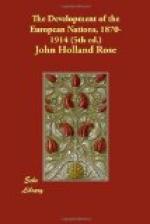Nevertheless, by the Treaties of Vienna (1814-15) the centre of Europe was more solidly organised than ever before. In place of the effete institution known as the Holy Roman Empire, which Napoleon swept away in 1806, the Central States were reorganised in the German Confederation—a cumbrous and ineffective league in which Austria held the presidency. Austria also gained Venetia and Lombardy in Italy. The acquisition of the fertile Rhine Province by Prussia brought that vigorous State up to the bounds of Lorraine and made her the natural protectress of Germany against France. Russia acquired complete control over nearly the whole of the former Kingdom of Poland. Thus, the Powers that had been foremost in the struggle against Napoleon now gained most largely in the redistribution of lands in 1814-15, while the States that had been friendly to him now suffered for their devotion. Italy was split up into a mosaic of States; Saxony ceded nearly the half of her lands to Prussia; Denmark yielded up her ancient possession, Norway, to the Swedish Crown.
In some respects the triumph of the national principle, which had brought victory to the old dynasties, strengthened the European fabric. The Treaties of Vienna brought the boundaries of States more nearly into accord with racial interests and sentiments than had been the case before; but in several instances those interests and feelings were chafed or violated by designing or short-sighted statesmen. The Germans, who had longed for an effective national union, saw with indignation that the constitution of the new Germanic Confederation left them under the control of the rulers of the component States and of the very real headship exercised by Austria, which was always used to repress popular movements. The Italians, who had also learned from Napoleon the secret that they were in all essentials a nation, deeply resented the domination of Austria in Lombardy-Venetia and the parcelling out of the rest of the Peninsula between reactionary kings somnolent dukes, and obscurantist clerics. The Belgians likewise protested against the enforced union with Holland in what was now called the Kingdom of the United Netherlands (1815-30). In the east of Europe the Poles struggled in vain against the fate which once more partitioned them between Russia, Austria, and Prussia. The Germans of Holstein, Schleswig, and Lauenburg submitted uneasily to the Danish rule; and only under the stress of demonstrations by the allies did the Norwegians accept the union with Sweden.
It should be carefully noted that these were the very cases which caused most of the political troubles in the following period. In fact, most of the political occurrences on the Continent in the years 1815 to 1870—the revolts, revolutions, and wars, that give a special character to the history of the century—resulted directly from the bad or imperfect arrangements of the Congress of Vienna and of the so-called Holy Alliance of the monarchs




